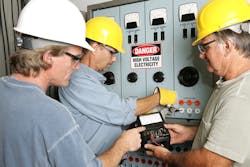Study Looks at Electrical Incidents as Cause of Contractor Deaths
A total of 325 contract workers died as a result of electrical injury in the U.S. in the five years from 2012 to 2016. A recent study by the National Fire Protection Association (NFPA) looked into the numbers compiled by the U.S. Bureau of Labor Statistics' in its annual Census of Fatal Occupational Injuries (CFOI) to examine the various factors in those fatal electrical injuries and what they say about how contractors and the firms that hire them can address their shared responsibility for electrical safety.
Of those 325 fatalities, almost one-third of victims (32%) were employed by electrical contractors or other wiring installation contractors, and 68% of contractors who died as a result of exposure to electricity worked in construction and extraction occupations. Of these, 57% were in construction trades occupations, including electricians (31%), construction laborers (11%), and roofers (5%). Nearly one-fifth of remaining victims worked in installation, maintenance, and repair occupations (18%), most of whom were line installers and repairers (11%). Workers in service occupations accounted for 4% of deaths, with 3% in building and grounds cleaning and maintenance occupations.
The fatalities occurred in a variety of places but construction sites led the list. Just over two in five contractor deaths (43%) due to exposure to electricity occurred at an industrial place or premise, with 28% of these at a construction site, 5% at a factory or plant, and 2% at a warehouse. Another 15% of these deaths occurred at a private residence, 10% of which were residential construction locations. Streets or highways and public buildings were each the location of 14% of the deaths, the study found.
In the report's discussion of the data, NFPA senior research analyst Richard Campbell said, "Inasmuch as these are fatal injuries, it is important to recognize that electrical safety training is likely to be needed not only by workers who are electrical specialists, but many others who may be exposed to electrical hazards in their work activities."
"Ensuring contractor electrical safety at the worksite is a joint responsibility of the firms directly employing the worker, such as a staffing agency or subcontractor, and the host employer that hires the contractor," the study said. "Host employers should include safety experience as a criterion in selecting contracting employers and ensure that contract employees have the necessary safety competencies to perform the assigned work, beyond any training provided by the host employer specific to the work task. Contracting employers, in turn, need to ascertain that contract workers in their employ are placed with host employers who provide safe working conditions."
